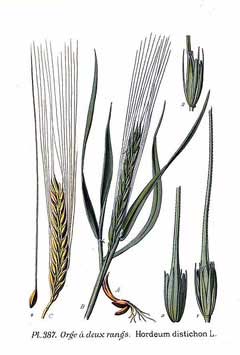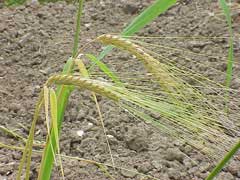 |
|
http://commons.wikimedia.org/wiki/File:387_Hordeum_distichon_L.jpg |
 |
| biolib.de |
Translate this page:
Summary
Physical Characteristics

 Hordeum distichon is a ANNUAL growing to 1.2 m (4ft).
Hordeum distichon is a ANNUAL growing to 1.2 m (4ft).
See above for USDA hardiness. It is hardy to UK zone 4 and is not frost tender. It is in flower from June to August. The species is hermaphrodite (has both male and female organs) and is pollinated by Wind.
Suitable for: light (sandy), medium (loamy) and heavy (clay) soils and prefers well-drained soil. Suitable pH: mildly acid, neutral and basic (mildly alkaline) soils. It cannot grow in the shade. It prefers moist soil.
UK Hardiness Map
US Hardiness Map
Synonyms
H. vulgare distichon.
Plant Habitats
Cultivated Beds;
Edible Uses
Edible Parts: Seed
Edible Uses: Coffee Salt Sweetener
Seed - cooked. The seed can be ground into a flour and used as a cereal in making bread, porridge etc[1, 4, 34, 46]. Malt is obtained by sprouting and roasting the seed, then boiling the seed. The resulting liquid is a sweet substance that is used in making beer and as a food[4, 46]. The longer the seed is roasted, the darker this liquid will be. The roasted (unsprouted) seed is used as a coffee and a salt substitute[46].
References More on Edible Uses
Medicinal Uses
Plants For A Future can not take any responsibility for any adverse effects from the use of plants. Always seek advice from a professional before using a plant medicinally.
Antidiarrhoeal Demulcent Nutritive Urinary
Barley grain is an excellent food for convalescence, either in the form of porridge or as a decoction of the seed. It is soothing to the throat and provides easily assimilated nutrients[4, 254]. It can also be taken to clear catarrh. Its demulcent properties soothes inflammation of the gut and urinary tract[254]. It is commonly given to children suffering minor infections or diarrhoea and is particularly recommended as a treatment for feverish states and in catarrhal affections of the respiratory and urinary organs[4, 254]. Made into a poultice, the seed is an effective remedy for soothing and reducing inflammation in sores and swellings[254]. Modern research has shown that barley may be of aid in the treatment of hepatitis, whilst other trials have shown that it may help to control diabetes[254]. Barley bran may have the effect of lowering blood cholesterol levels and preventing bowel cancer[254].
References More on Medicinal Uses
The Bookshop: Edible Plant Books
Our Latest books on Perennial Plants For Food Forests and Permaculture Gardens in paperback or digital formats.

Edible Tropical Plants
Food Forest Plants for Hotter Conditions: 250+ Plants For Tropical Food Forests & Permaculture Gardens.
More

Edible Temperate Plants
Plants for Your Food Forest: 500 Plants for Temperate Food Forests & Permaculture Gardens.
More

More Books
PFAF have eight books available in paperback and digital formats. Browse the shop for more information.
Shop Now
Other Uses
Biomass Mulch Paper
The stems, after the seed has been harvested, have many uses. They are a source of fibres for making paper, a biomass for fuel etc, they can be shredded and used as a mulch[141, 171].
Special Uses
References More on Other Uses
Cultivation details
Succeeds in most soils and in climates ranging from sub-arctic to sub-tropical[1, 171]. Easily grown in light soils[162]. Widely cultivated in temperate zones, especially in cooler or moister areas, for its edible seed[1, 50, 171]. There are many named varieties. This species is sometimes considered to be no more than a sub-species of H. vulgare[61].
References Carbon Farming Information and Carbon Sequestration Information
Temperature Converter
Type a value in the Celsius field to convert the value to Fahrenheit:
Fahrenheit:
The PFAF Bookshop
Plants For A Future have a number of books available in paperback and digital form. Book titles include Edible Plants, Edible Perennials, Edible Trees,Edible Shrubs, Woodland Gardening, and Temperate Food Forest Plants. Our new book is Food Forest Plants For Hotter Conditions (Tropical and Sub-Tropical).
Shop Now
Plant Propagation
Seed - sow in situ in March or October and only just cover the seed. Make sure the soil surface does not dry out if the weather is dry. Germination takes place within 2 weeks.
Other Names
If available other names are mentioned here
Native Range
Coming Soon
Weed Potential
Right plant wrong place. We are currently updating this section.
Please note that a plant may be invasive in one area but may not in your area so it's worth checking.
Conservation Status
IUCN Red List of Threatened Plants Status :

Growth: S = slow M = medium F = fast. Soil: L = light (sandy) M = medium H = heavy (clay). pH: A = acid N = neutral B = basic (alkaline). Shade: F = full shade S = semi-shade N = no shade. Moisture: D = dry M = Moist We = wet Wa = water.
Now available:
Food Forest Plants for Mediterranean Conditions
350+ Perennial Plants For Mediterranean and Drier Food Forests and Permaculture Gardens.
[Paperback and eBook]
This is the third in Plants For A Future's series of plant guides for food forests tailored to
specific climate zones. Following volumes on temperate and tropical ecosystems, this book focuses
on species suited to Mediterranean conditions—regions with hot, dry summers and cool, wet winters,
often facing the added challenge of climate change.
Read More
Expert comment
Author
L.
Botanical References
50
Links / References
For a list of references used on this page please go here
Readers comment
| Add a comment |
|
If you have important information about this plant that may help other users please add a comment or link below. Only comments or links that are felt to be directly relevant to a plant will be included. If you think a comment/link or information contained on this page is inaccurate or misleading we would welcome your feedback at [email protected]. If you have questions about a plant please use the Forum on this website as we do not have the resources to answer questions ourselves.
* Please note: the comments by website users are not necessarily those held by PFAF and may give misleading or inaccurate information.
To leave a comment please Register or login here All comments need to be approved so will not appear immediately.
|
Subject : Hordeum distichon
|
|
|
|